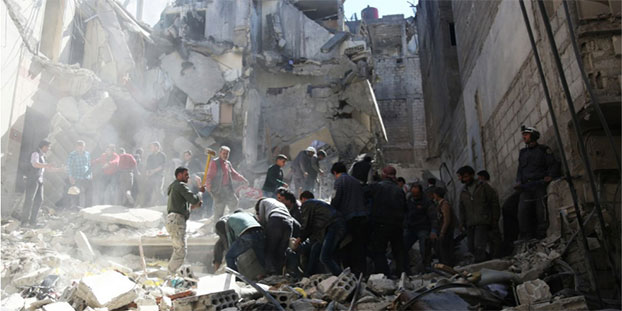The era of long-term government sieges in Syria is over. The last long-term government siege ended this week when the Syrian government declared Yarmouk camp to be “cleared of terrorists”. Unfortunately, however, the suffering caused by these sieges is far from over.
The sieges were not ended through sustainable, diplomatic means. Instead, the government and its allies brought their “surrender or die” strategy to its brutal conclusion. Most sieges ended in bloody scorched earth offensives and surrender deals that included illegal mass forced population transfers. This after years of starvation, bombing, and psychological warfare. Entire cities, towns, and neighbourhoods lie in ruins, and many of the residents will never be allowed to return home.
After Ghouta
The largest besieged enclave in Syria, Eastern Ghouta, surrendered in April. Since then, the other remaining areas besieged by the Syrian government and its allies were subjected to increased military attacks, threats, and intense pressure, resulting in the surrender of the Southern Damascus Suburbs and the besieged enclaves of northern Homs. Tens of thousands of people have been forcibly transferred to northern Syria as part of these deals, where they join more than a hundred thousand others who were forcibly displaced before them.
High cost
While the end of the sieges has brought one tragic chapter of the war to a close, it has done so at an unimaginably high cost. Those who were displaced, those who remain in post-surrender communities, and those who have been taken into government custody face new threats. The social fabric of the country has been destroyed. Northern Syria is overflowing with internally displaced people and packed with uprooted armed groups, an explosive combination.
Last Siege Watch report
The tenth quarter of the Siege Watch project monitoring efforts will be the last. The tenth quarterly report will cover developments since February 2018, and will be published in two parts. Part 1 on Eastern Ghouta will be published in June, followed by a Part 2 report on the Southern Damascus Suburbs, northern Homs, and other remaining areas. The Siege Watch project will conclude with a final report analysing trends over time and looking at larger questions about the role of sieges in the Syrian conflict.
Stand with the victims
PAX has raised awareness about starvation and other International Humanitarian Law violations as part of sieges and their aftermath in Syria since 2013, and through the Siege Watch project, has further documented the use of siege tactics by multiple parties to the conflict in Syria since 2015, including by the anti-ISIS coalition. We are extremely concerned about the precedent created by the failure of the international community to exert the political pressure needed to break the sieges, to protect civilians, and to address the persistent interference in aid delivery. We call on the international community to stand with the victims and survivors of war crimes in Syria, to prioritise transitional justice and to hold those responsible for war crimes in Syria accountable.




